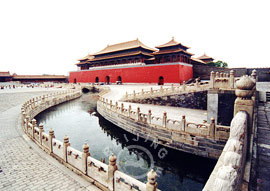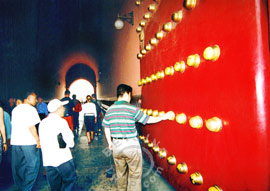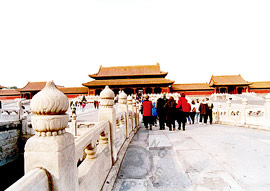 Meridian Gate
Meridian Gate
 Meridian Gate (Wu Men) is the main gate and the south gate of the Forbidden City. As the greatest of the gates, it is also the highest building of the Forbidden City. Five pavilions with golden glaze tiles, like five phoenixes, sit on the gate, thus the gate is also called Five-Phoenix Pavilion. Bells and drums reside in the two pavilions closest to the main pavilion. The bells would ring when the emperor left the Meridian Gate for the Temple of Heaven; and the drums would beat when the emperor departed for the Ancestral Temple. Bells and drums also volleyed when grand ceremonies were hold in the palace.
Meridian Gate (Wu Men) is the main gate and the south gate of the Forbidden City. As the greatest of the gates, it is also the highest building of the Forbidden City. Five pavilions with golden glaze tiles, like five phoenixes, sit on the gate, thus the gate is also called Five-Phoenix Pavilion. Bells and drums reside in the two pavilions closest to the main pavilion. The bells would ring when the emperor left the Meridian Gate for the Temple of Heaven; and the drums would beat when the emperor departed for the Ancestral Temple. Bells and drums also volleyed when grand ceremonies were hold in the palace.

The gate has five entrances, each of which allowed people with certain ranks to come in. The entrance in the middle was reserved for the emperor; however, there were some exceptions to this rule. The empress had the right to enter through it only on her wedding day and the top three students who succeeded in the Final Imperial Examination were entitled to leave the palace via this central entrance. The side entrance on the east was for the ministers and the side entrance on the west for the royal family members. The other two flanking entrances were opened on grand ceremony occasions, permitting officials to pass.
During the imperial period many activities took place at the Meridian Gate. At the end of a lunar year, the emperor issued the calendar for the next year. When the army returned in triumph after wars, the emperor greeted them and received the captives at the Meridian Gate.
Gate of Supreme Harmony (Taihe Men) is the main entrance to the grand Outer Court. Accompanied by other two smaller gates, it reveals a sense of majesty. The gate is guarded by a pair of bronze lions which are the biggest pair of the palace. The male one in the east is stepping on a ball, which symbolize the supreme power of the emperor. The lioness in the west strokes a baby lion, representing that the royal family will have a large number of successors. In front of the gate, there is a large square reaching to the Meridian Gate. This treeless square is livened by a twisting river with five charming bridges called Inner Golden Water River.
In the Ming Dynasty (1368 -1644), the gate was called 'Fengtian Men' where the emperor held court to handle state affairs in the early morning. When the court was held, the imperial officials entered the palace in procession through Meridian Gate and then lined up in the order of rank on the square. The emperor listened to his official's explanation of the affairs, received the documents and made decisions on the matters. During the Qing Dynasty (1644-1911), it was given the present name-Taihe Men. The emperors of the Qing Dynasty (1644-1911) used to hold banquets, accepted offerings and interviewed diplomatic representatives at the gate.
 Go to the Next Attractions: Hall of Supreme Harmony & Hall of Central Harmony
Go to the Next Attractions: Hall of Supreme Harmony & Hall of Central Harmony
